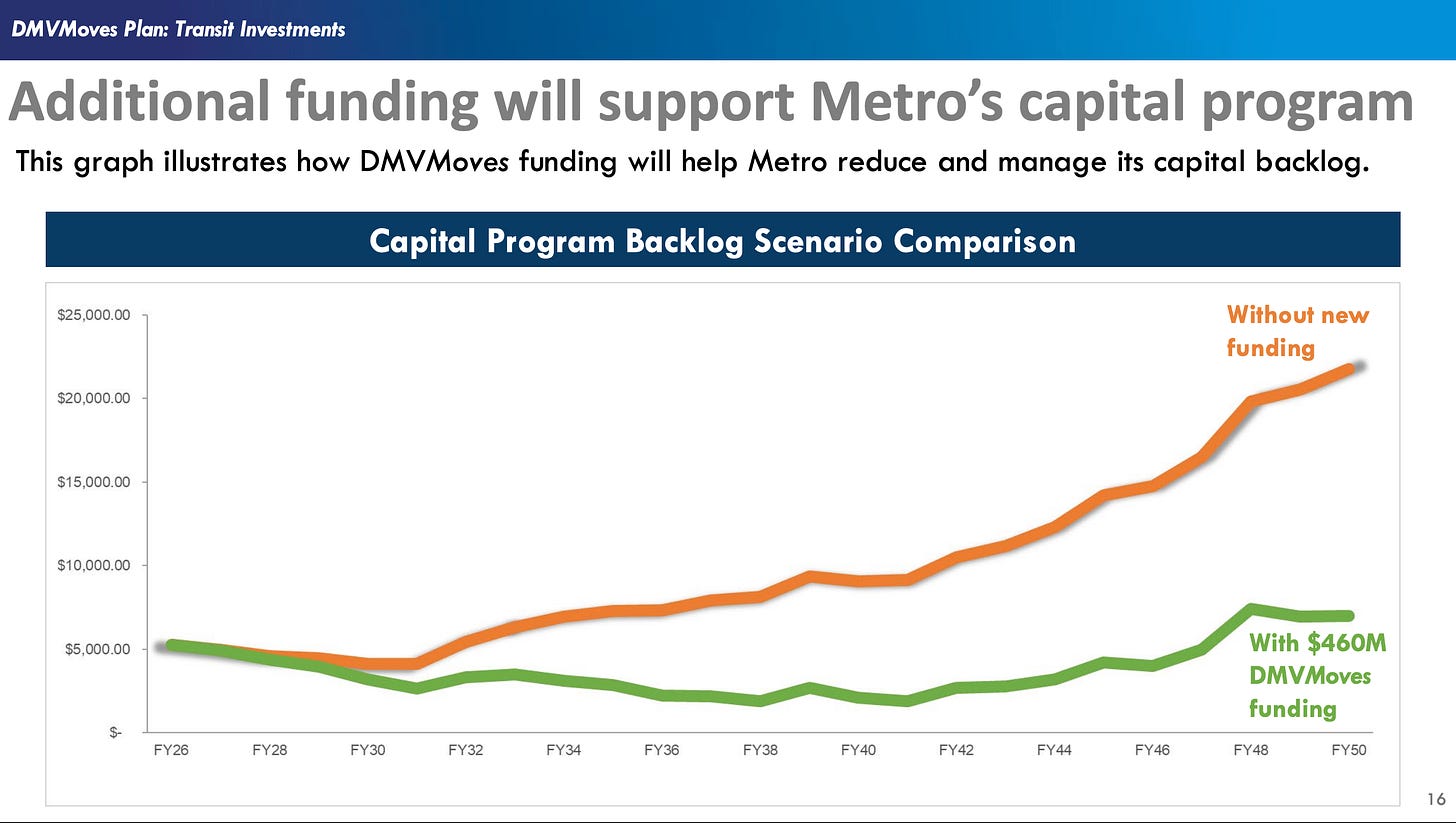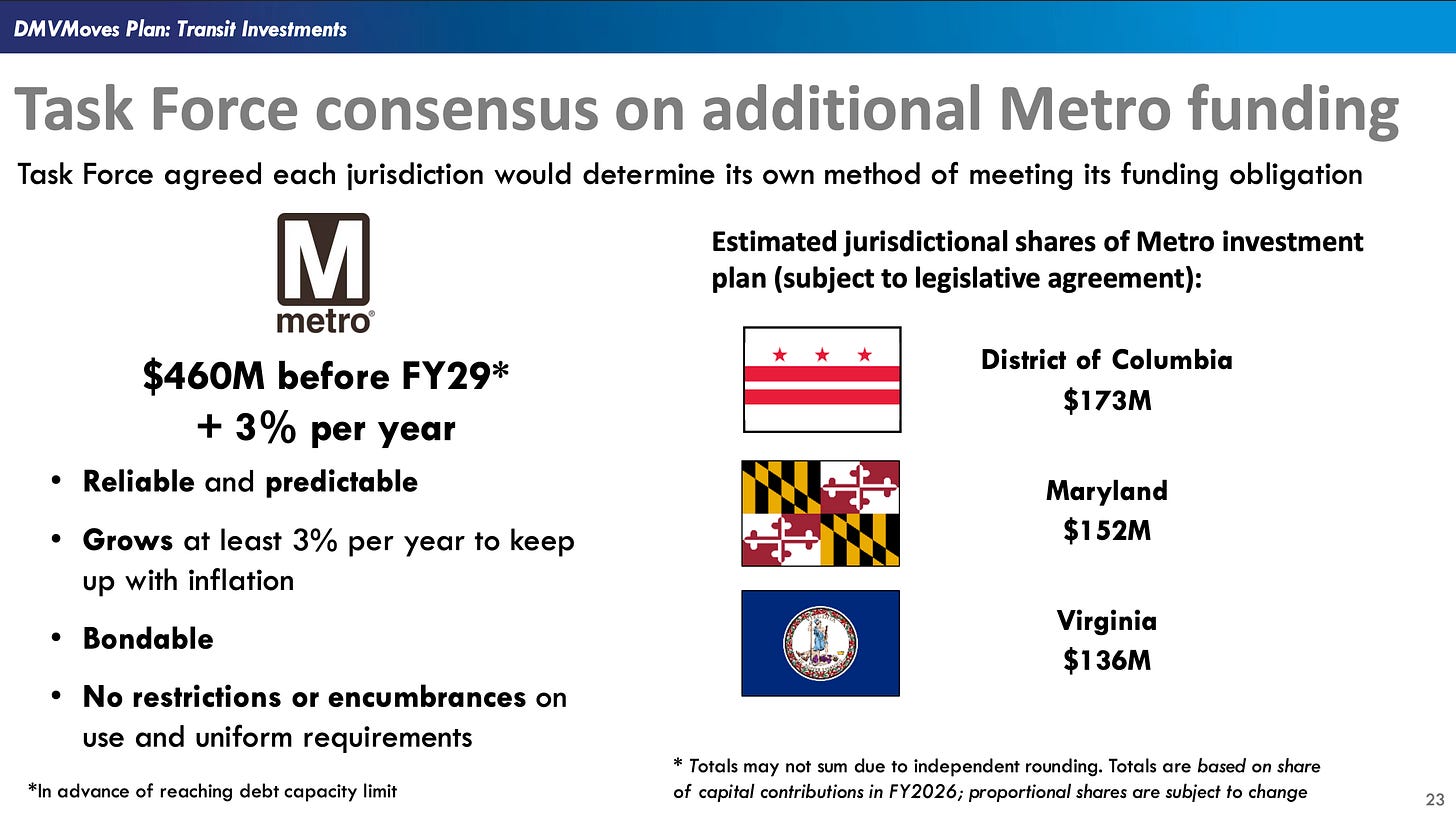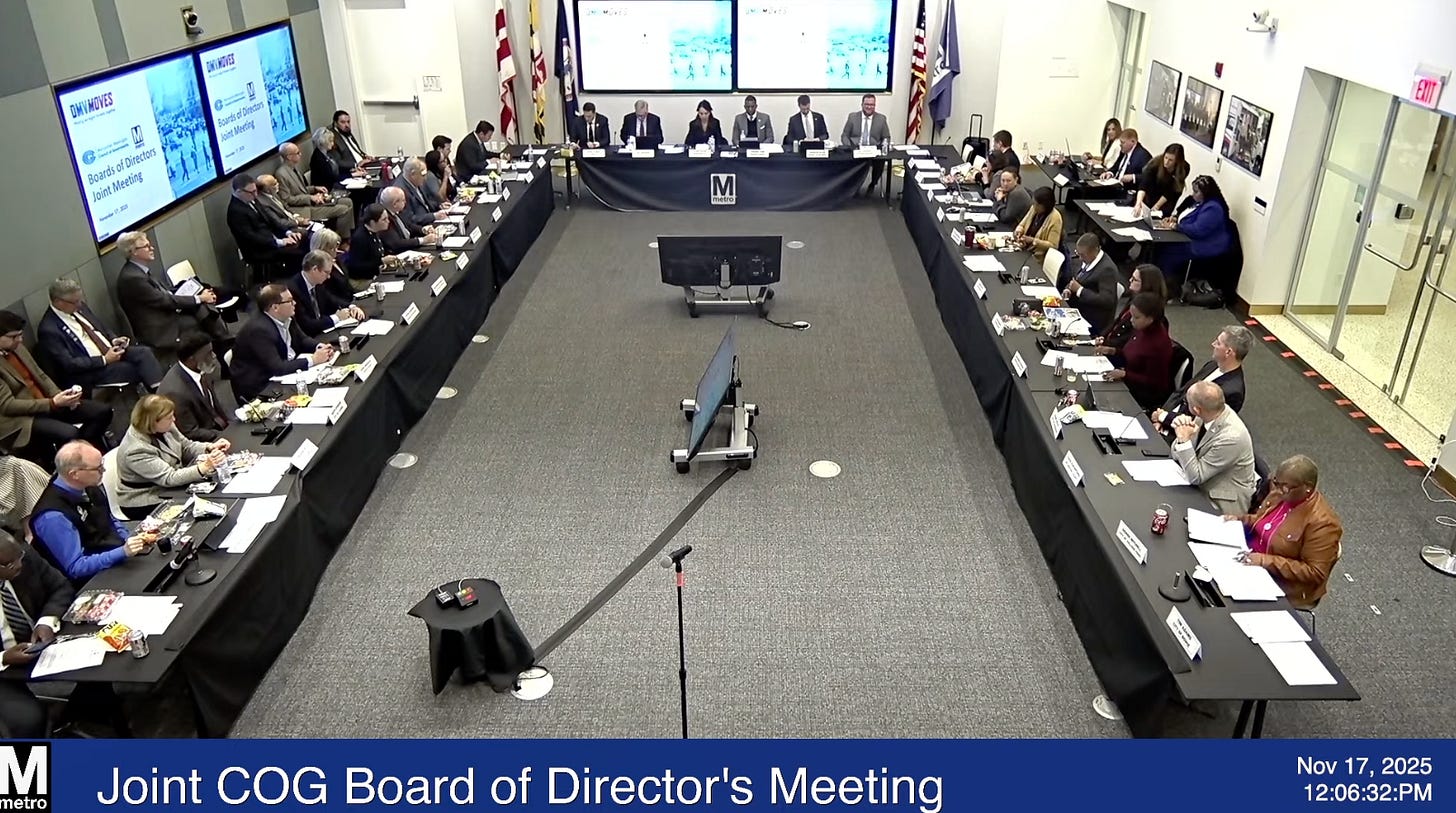Regional transit boards adopt DMVMoves plan calling for $460 million in Metro funding
Resolution calls for dedicated funding starting in fiscal 2028, with Virginia's share at $136 million annually
Regional leaders approved a plan Monday that calls for Virginia to contribute $136 million annually to Metro starting in fiscal 2028.
The Metropolitan Washington Council of Governments and WMATA boards jointly endorsed the DMVMoves initiative, an 18-month effort to develop a sustainable funding model for the region’s transit network. The resolution adopted the broader DMVMoves regional transit plan, with Metro’s $460 million capital funding request — split among Virginia, Maryland and the District of Columbia — as the centerpiece. The plan also calls for legislative support for commuter rail and local bus systems, though specific funding amounts for those systems remain to be determined.
The COG board approved the resolution 22-0 with two abstentions. The WMATA board approved it with one dissenting vote.
“We simply have never before tackled this many challenges and laid out a vision of how we work as a region to solve them,” said Charles Allen, a D.C. councilman, COG vice chair and task force co-chair.
The resolution is non-binding and serves as an advocacy tool for state legislative efforts in 2026.
Alexandria’s interest
Alexandria has five Metro stations — King Street-Old Town, Potomac Yard, Braddock Road, Eisenhower Avenue, and Van Dorn Street. King Street Station connects Metro, VRE, and Amtrak.
Alexandria Mayor Alyia Gaskins, who sits on the COG board and voted for the resolution, asked Metro officials how the plan’s success would be measured.
“Can you provide examples of what some of those performance measures might look like?” Gaskins asked during board discussion. “For example, if the goal is access to opportunity, how are we making sure that we’re achieving that through this plan?”
She also asked how frequently the overall capital plan would be revisited and updated.
Nick Donohue, the DMVMoves facilitator, said Metro currently updates a six-year capital improvement program annually. Under the plan, Metro would also develop a 20-year capital plan every five years “to give you all as local decision makers some sense of what the needs are into the future.”
The plan includes annual reporting to track whether Metro meets key assumptions, including projected 2% ridership growth, Donohue said.

Metro’s funding challenge
Metro will reach its debt capacity limit in fiscal 2029, which will force annual capital spending to drop from $2.2 billion to $1.4 billion, according to DMVMoves projections.

“We are going to have to replace our signaling system at some point. It’s not a debatable thing,” Metro General Manager Randy Clarke said. “The question is how long is it going to take and how much pain are we going to purposely put ourselves in and how proactive we are versus how reactive.”
Metro’s signaling technology dates to the 1970s, and vendors are stopping production of replacement parts, Clarke said.

Without new funding, Metro’s capital backlog would grow from about $5 billion to $22 billion by 2050, according to DMVMoves projections. With funding growing at 3% annually, the backlog would remain at $3 billion to $4 billion, according to the plan.
Metro’s recent performance
Metro has experienced significant growth since 2018, when the region committed $500 million annually in dedicated funding:
Named American Public Transportation Association’s transit agency of the year
54 consecutive months of ridership growth
24 million-plus trips monthly
Crime down 55% to an eight-year low
Fare evasion down 82%
Customer satisfaction at 92% on rail, 83% on bus
Fiscal 2025 ended $120 million under budget
More than 30,000 cameras monitoring the system
Since 2022, Metro has completed transit-oriented development projects that generated $15 million in tax revenue from housing, office and retail space, according to WMATA.
The 2018 dedicated funding was not indexed to inflation, Clarke said.
“A reliable and well-funded Metro system is essential to our region’s economic vitality,” Clarke said in a statement after the vote. “These recommendations provide a roadmap to modernize our transportation network, deliver safer and more reliable service, and ensure Metro continues to connect people to opportunities for generations to come.”
Funding allocation

The plan allocates funding based on existing Metro capital formulas:
District of Columbia: $173 million (38%)
Maryland: $152 million (33%)
Virginia: $136 million (30%)
Funding must be “predictable, multiyear” and structured to support a revolving bond program that grows at least 3% annually, according to the resolution. Each jurisdiction will determine its own funding mechanism.

D.C. Councilman Jack Mendelson abstained from the COG vote.
“I feel that if I were to vote no on the resolution, that would be misconstrued as not supporting this regional effort,” Mendelson said. “I just can’t say yes with regard to a $173 million commitment. Recognize this is non-binding but nonetheless it is a vote and I can’t say yes to $173 million and we don’t got it.”
The District has committed to a 1% sales tax increase for transit in fiscal 2027, Mendelson said.
Planned investments
The funding would support:
Rail modernization: Replacing the 1970s-era signaling system with modern technology that could improve safety, reliability, capacity and efficiency.
Fleet replacement: New railcars and buses.
Infrastructure repairs: Traction power cables, escalators, elevators, track, tunnels and stations.
Bus priority network: Dedicated lanes and signal priority on corridors including Georgia Avenue in Maryland, Columbia Pike and Route 7 in Virginia, and crosstown routes in D.C.
The plan does not include new Metro rail lines.
“We have to address the core capacity issues between Rosslyn and Stadium Armory before we think about or try and work on some of those extensions,” said Paul Smedberg, WMATA board vice chair and task force co-chair.
Accountability measures
The resolution requires Metro to:
Publish a 20-year capital plan every five years, with the first due in July 2027
Provide public funding plans for projects over $300 million
Deliver annual performance reports to COG and the public
Apply Metro’s 3% operating cap to per-unit costs
Include analysis of opportunities to be more cost efficient
COG will monitor progress and issue annual public reports on implementation.
“The DMVMoves plan is a major milestone for our region, but it isn’t an end point,” said COG Executive Director Clark Mercer in a statement. “Our region has produced some great plans in the past whose goals were not fully achieved. This time, COG, Metro, and our partners have outlined the path forward to ensure these recommendations are implemented and that we hold ourselves accountable to delivering our shared vision for world-class transit.”
Other transit needs
The resolution identifies additional funding needs:
Commuter rail: $60 million annually for MARC and VRE to maintain current service levels.
Local bus systems: $65 million to $80 million annually to meet regional service guidelines.
These amounts are separate from Virginia’s $136 million Metro contribution.
Regional Support
Rodney Lusk, COG board chair and a Fairfax County supervisor, said the plan demonstrates regional collaboration.
“The DMVMoves Task Force has shown what’s possible when our region comes together to plan for the future,” Lusk said in a statement. “Transit propels our region’s economy forward, and this collaboration is a clear call to action. We must move forward together to secure a sustainable future for everyone who depends on Metro and our entire transit network.”
Metro Board Chair Valerie Santos said regional cooperation will be essential for implementation.
“Our region’s prosperity depends on having a safe, resilient, and reliable Metro—the world-class transit system our communities deserve,” Santos said in a statement. “Together, the COG and Metro boards support the vision articulated in the DMVMoves plan and urge our regional and state partners to work together to secure the sustainable, dedicated funding necessary to make that vision a reality.”
Legislative process
Del. Mark Sickles, a Virginia task force member, said he is optimistic about the 2026 General Assembly session. Two bills are in development — one focused on transit and VRE, another addressing transportation and education needs, Sickles said.
Maryland Deputy Secretary Joe McAndrew said the state cannot fund transit “at the expense of other investments” without new revenue sources.
All three jurisdictions must approve their shares for the plan to work.
Next steps
Legislative action is targeted for 2026 sessions in all three jurisdictions. Implementation must occur before Metro reaches its debt capacity limit in fiscal 2029.
The DMVMoves initiative was created in May 2024 by the boards of COG and Metro. The task force was chaired by Allen and Smedberg, with advisory groups chaired by Fairfax County Executive Bryan Hill and Greater Washington Board of Trade President and CEO Jack McDougle.
Those interested can watch the meeting below.
Updates
3:40 p.m.: The first paragraph of this story has been updated for clarity, replacing “would require” with “calls for,” as the vote taken was non-binding.
4:10 p.m.: This story was updated with additional reaction.
This story was published as part of The Transportation Brief, which provides regular deep dives into how Alexandria moves. Subscribe here to get transportation coverage delivered to your inbox.


